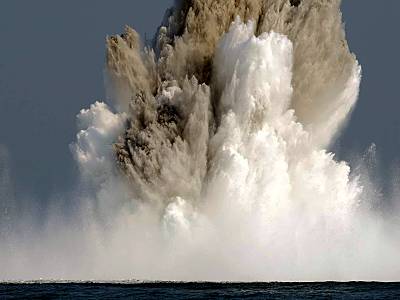British forces have created a new Infantry Branch School in the mountainous outskirts of Kabul in partnership with the Afghan National Army (ANA).
 |
| An Afghan infantry instructor being trained in the use of a heavy machine gun by a British advisor Source: Corporal Barry Lloyd RLC, Ministry of Defence, UK Click to enlarge |
The purpose of the new school is for British troops to teach ANA soldiers infantry tactics and support weapons use above and beyond their basic training.
Based on similar training facilities in the UK, such as the Infantry Battle School in Brecon, Wales, and the Support Weapons School in Warminster, Wiltshire, the new infantry school is part of a wider initiative by ISAF to set up specialist training facilities for different elements of the Afghan Army, in the same way that coalition forces operate.
This includes training establishments for communications, logistics, armour and engineering.
The key objective is to develop Afghan soldiers’ knowledge to cover military tactics and the use of their weapons in support of their other military units. Ultimately this creates a more rounded and tactically-capable Afghan force.
Commanding Officer of the Infantry Advisory Group, Lieutenant Colonel Jeremy Pughe-Morgan, said:
“What the infantry school is going to do is focus on developing junior leadership and tactical skills for platoon commanders, platoon sergeants and squad leaders from the ANA.
“We run exactly the same courses as they do in the UK, the ANA are the instructors, we are merely here to make sure they follow the programme of instruction and make the best of what they can do with the resources that they have.”
Seen as experts in infantry training and doctrine, UK officers and senior non-commissioned officers from the Infantry Advisory Group will take nearly 20,000 students a year through qualification courses reflecting their roles.
The school is broken down into three wings: an officer wing which conducts platoon commanders’ training, a non-commissioned officers wing which trains platoon sergeants and junior commanders, and a soldiers wing which provides training in reconnaissance and support weapons, such as mortars, the heavy machine gun, the rocket-propelled grenade and the SPG‑9 anti-tank gun.
Lt Col Pughe-Morgan added:
“The majority of our soldiers come from the Officer Candidate School, which is the Afghan equivalent of Sandhurst [the Royal Military Academy Sandhurst which trains British Army officers], or they come straight from basic warrior training to do the advance heavy weapons training.
“For the squad leaders and platoon sergeants that are coming back from the field, we’re seeing an increasingly tougher, more resilient NCO [non-commissioned officer] coming back and benefiting from the courses that we run.”
The courses and the training facilities have been designed by the British instructors to reflect training standards in the UK. In this instance, the British advisors, through the process of ‘train-the trainer’, are instructing and coaching the ANA to deliver the lessons and eventually to run the school themselves. It takes approximately three to six weeks to train an Afghan instructor to deliver a training package.
However, this approach has not been without challenges and there has been a need by the British troops to come up with new ways of teaching.
Due to the low levels of literacy within certain groups of students, the British soldiers have for example been using visual aids such as models to explain height and key features on the ground during navigation lessons. This paints a picture that the Afghan soldiers and instructors can easily understand.
Major Till Timmermann, Officer Commanding Heavy Weapons Company, said:
“First of all we identified the training objectives, what we wanted to achieve, then we developed training programmes and lesson plans in English and Dari.”
Students go through classroom-based and practical outdoor lessons in weapon handling and firing, map reading, first aid, radio communications and reconnaissance before undertaking simulated training exercises and then assessed live firing exercises on the ranges at the culmination of their training.
Major Timmermann added:
“When the Infantry Advisory Group took over this task, one of the things we noticed was that students were only being taught on that weapon and how to fire it.
“We’ve taken the next step by involving tactics and manoeuvre into it; for example the machine gunners will learn not only how to secure and sight a gun line, but they will learn about the practical employment of using guns in support of other operations.
“I think one of the key successes of the Infantry Branch School is that we’re taking the soldiers, giving them the technical know-how, and they will bring that to the field Army. That means that for all the equipment that the Afghan National Army has, they will now have trained and qualified personnel operating it, and so will be able to maximise their capabilities in the field.”
Press release
Ministry of Defence, UK

 von
von 
